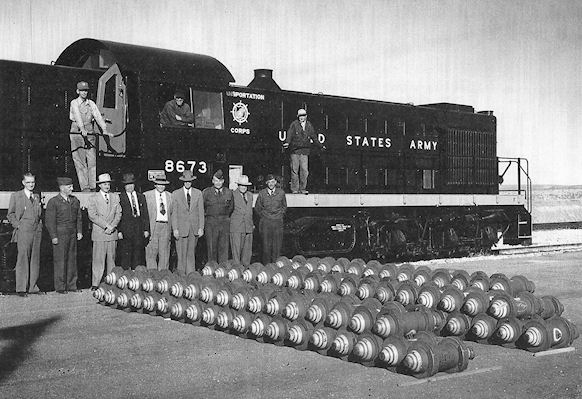

| Vol. 1 No. 1 | page 1 | Dec. 7, 1951 |
- - -
The Railroad Section Crew, (a part of the R & U Division) was the first group on the Depot to reach 100%.
- - -
| Vol. 2 No. 29 | page 3 | July 17, 1953 |
Lt. Colonel Roy B. Southworth, executive officer, proved his versatility as he demonstrated his abiility to handle a GE as well as a GI (the GE being one of the BHOD Diesel-Electric locomoties) on a tour of inspection of the trackage at this installation Tuesday morning.
Accompanied by Earl Larson in the capacity of engineer and George Batchelder as trainman the doughty Colonel started his trek around the depot in old Reliable, namely engine 7125. Taking over the throttle shortly after Larson had pulled out from the roundhouse, Col. Southworth operated like the veteran we suspect he is, handling the controls with such expertness and ease that the ride was described by his passengers as "smooth as silk" and "like floating on a cloud". (One of his passengers has had the experience of floating on clouds.) Of course due allowance is made for any rough track encountered if any.
The tour look in the loop in the explosives area with a trip into Combat. He herded the iron steed back into the barn with the deftness of a Hendrix or a Coen.
Col. Southworth praised the maintenance crews for the splendid condition of most of the trackage and expressed a desire for futher tours in the near future.
| Vol. 2 No. 30 | page 1 | July 24, 1953 |
Recent installlation of new-type flange oilers in the two Diesel-electric locomotives at BHOD brought to light some unheralded savings of considerable consequence over the past few years according to Earl Larson, Roundhouse Foreman.
In 1951, Mr. J. C. Christensen, Master Mechanic of the Fifth Army Area, visited the Depot on a periodic inspection of rail rolling stock. Chris, as he is familiarly called, remarked that the locomotives would soon require wheel changes as the flange oilers then in use were not giving satisfactory service. Excessive wear of the flanges would soon create a safety hazard. (One of the engines has since been replaced with a larger locomotive.)
Larson, then Diesel mechanic, suggested a different design for oilers and, given the green light by Christensen, proceeded to make and install them according to his own ideas. Regardless of some shortcomings the Larson-made product proved more satisfactory than the older type and its worth is attested by the fact that Enginee 7125 still has the same set of wheels that Chris was expecting to condemn within a short time in 1951.
Savings as a result of Larson's ingenuity can be reckoned as one complete set of wheels for Engine 7125 with a possible change due on Engine 8673 as well as time charged to crews doing the mechanical work. In addition the engine being deadlined would be lost to service for several days. Monetary savings for replacement parts are conservatively estimated at $2476 for wheel sets alone.
Mr. Larson and the locomoive engineers, Pat Hendrix and Dale Coen, are very enthusiastic over the new-type oilers just put into operation. Although Chris had said these would become standard equipment throughout the Fifth Army Area it was only recently that they were obtainable for local use.
| Vol. II No. 48 | page 2 | Nov. 27, 1953 |

Three officials of the - - - the Burlington from Deadwood; George F. Jones, the railroad's executive general agent from Scottsbluff, Nebraska; Noah E. McKinney, the Depot's Transportation Officer; S. R. Harris, division superintndent of the Burlington at Alliance; Lt. Col. Roy B. Southworth, Jr., Executive Officer; Gerner Olsen, Chief of Storage Division; and Captain Milton J. Drain, Acting Assistant for Supply Operations. Making up the BHOD train crew, left to right, are: Alfred Ferdig, brakeman; Sherman Hendrix, engineer; and Kenneth Hyatt, conductor.
(under construction)